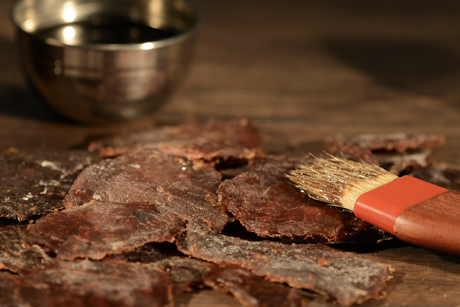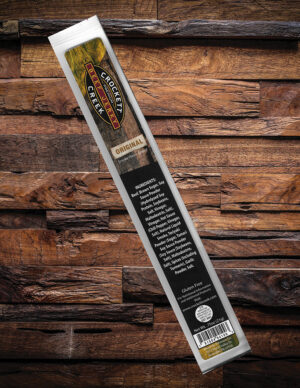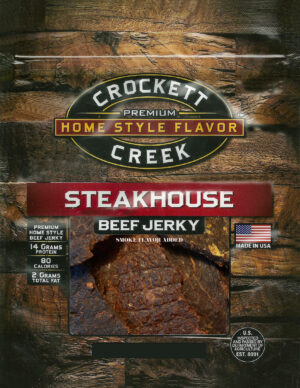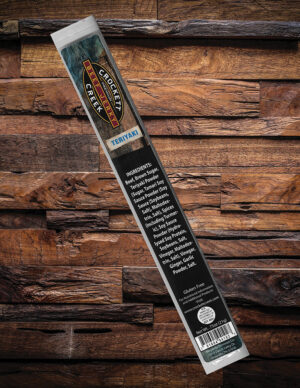If you’re like the rest of us, jerky is your all-time favorite snack—and for good reason. It comes in a variety of flavors, is healthy, and doesn’t need to be refrigerated, making it the ultimate on-the-go snack or meal. If you’re a true jerky fanatic, you probably finish the bag in one sitting and never have to worry about how long it’ll last. But for jerky semi-fans who take a little longer to get through a bag, you’ve likely wondered how long you can snack on it before it’ll go bad. You may have even assumed that the lack of refrigeration must mean jerky has an eternal shelf life and will never go bad. We’ll clear up this confusion: yes, jerky can go bad. But how long can jerky last, how do you know if it has gone bad, and how can you make it last longer? Here are the answers to your most burning questions about jerky shelf life.
What Is the Shelf Life of Jerky?
They say all good things must come to an end, and the same is true for jerky—it can’t last forever. Commercially packaged jerky that you buy from the store or online typically has a shelf life of about one year. These packages will usually include a “best by” date to give you an idea of the ideal timeframe for enjoying the jerky at its freshest. If the package remains unopened, the jerky may still be good for a month or two past the date on the bag.
After you open a package of jerky, the shelf life shortens. Opened packages of commercial jerky will stay fresh for about one to two weeks in the pantry or three to four weeks in the refrigerator. Of course, jerky from big-name companies will last longer if they’re loaded with extra preservatives. More preservatives mean the jerky will be less affected by exposure to air and moisture.
Homemade jerky’s shelf life, on the other hand, is a lot shorter than commercially packaged jerky. It’s all dependent on how you package the jerky. If you vacuum-seal the package, the jerky will last roughly one to two months in the pantry or longer if stored in the refrigerator. If you don’t vacuum-seal it, then the jerky will last about one to two weeks in the pantry or about one month in the refrigerator.
How Can I Tell If Jerky Has Gone Bad?
Let’s say you opened a bag of beef jerky and couldn’t finish it all at once, so you set it back in the pantry and forgot about it for a little while. As you’re cleaning out your pantry, you come across the bag once again and consider whether or not it’ll still be safe to eat. How can you tell if the jerky is bad? Well, in most cases, all you have to do is open the bag and give it a sniff. If the jerky has gone bad, you’ll smell the unmistakable odor of rotten meat, which will be a good indicator that you shouldn’t eat it.
There are also visual cues that can let you know if jerky has gone bad, though they’re not as obvious as the sniff test. Jerky will only really appear to have spoiled if mold has started to grow on it, but jerky that has gone bad does not always do this. When it’s at or near its expiration, jerky also may be a darker color and feel harder than normal.
What Happens If I Eat Spoiled Jerky?
If you make the mistake of eating jerky that has gone bad, you will probably become ill. Spoiled meat is one of the worst things to eat, and it can lead to food poisoning. Some of the symptoms of food poisoning are nausea, abdominal pain, fever, headaches, and gastrointestinal problems. Jerky that has gone bad can also grow bacteria that can cause you to become ill if ingested.
However, there is good news. It’s very unlikely that you will get sick from eating spoiled jerky because you’ll be able to tell it has gone bad before you consume enough to make you sick. The smell of spoiled jerky should be enough to keep you from putting it in your mouth, and even if you do, you’ll immediately spit it out because it will not taste good. As long as you don’t eat it when it smells or tastes funny, you’ll be fine.
How Can I Extend the Shelf Life of Jerky?
There are a few things you can do to help make your jerky last longer. One of the best ways to increase jerky shelf life is by storing it in the freezer. The freezing temperatures and lack of moisture will make it virtually impossible for bacteria and other contaminates to make your jerky go bad.
You can also use desiccants, or drying agents, to keep moisture out of your jerky. Most bags of jerky come with a small oxygen absorber packet inside, which helps control any air and moisture that may have gotten into the bag when it was sealed. You can take this a step further by making small bags of rice in very thin cloth. Pack these bags around your jerky to make sure it always stays dry.
To extend the shelf life of your homemade jerky, you should carefully cut out all the fat before drying the meat. Fat is the first part to go bad, and when it does, it ruins the entire batch. The less fat in the jerky, the less likely it is to rot quickly.
Get Fresh Jerky from Crockett Creek
Here at Crockett Creek, we don’t load our jerky up with preservatives to give it a longer shelf life, but we do everything else we can to guarantee your jerky will stay fresh for a long time. We use only high-quality ingredients, lean cuts of meat, and the best drying and packaging practices to keep out harmful moisture, including oxygen absorbers and food-grade nitrogen for freshness. Each batch of jerky is crafted by hand to ensure quality and flavor in every bag. Satisfy your jerky cravings with the freshest, tastiest, highest-quality jerky around. Take a look at all the flavors we have to offer and buy a few bags of Crockett Creek’s premium jerky today!





